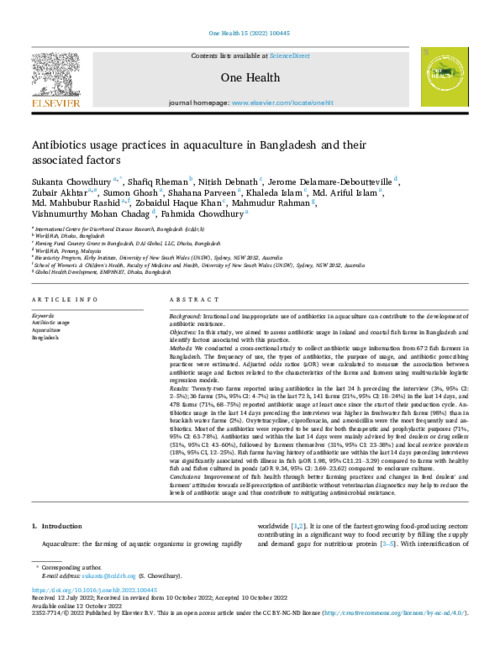Antibiotics usage practices in aquaculture in Bangladesh and their associated factors

Background: Irrational and inappropriate use of antibiotics in aquaculture can contribute to the development of antibiotic resistance.
Objectives: In this study, we aimed to assess antibiotic usage in inland and coastal fish farms in Bangladesh and identify factors associated with this practice.
Methods: We conducted a cross-sectional study to collect antibiotic usage information from 672 fish farmers in Bangladesh. The frequency of use, the types of antibiotics, the purpose of usage, and antibiotic prescribing practices were estimated. Adjusted odds ratios (aOR) were calculated to measure the association between antibiotic usage and factors related to the characteristics of the farms and farmers using multivariable logistic regression models.
Results: Twenty-two farms reported using antibiotics in the last 24 h preceding the interview (3%, 95% CI: 2–5%); 36 farms (5%, 95% CI: 4–7%) in the last 72 h, 141 farms (21%, 95% CI: 18–24%) in the last 14 days, and 478 farms (71%, 68–75%) reported antibiotic usage at least once since the start of their production cycle. Antibiotics usage in the last 14 days preceding the interviews was higher in freshwater fish farms (98%) than in brackish water farms (2%). Oxytetracycline, ciprofloxacin, and amoxicillin were the most frequently used antibiotics. Most of the antibiotics were reported to be used for both therapeutic and prophylactic purposes (71%, 95% CI: 63–78%). Antibiotics used within the last 14 days were mainly advised by feed dealers or drug sellers (51%, 95% CI: 43–60%), followed by farmers themselves (31%, 95% CI: 23–38%) and local service providers (18%, 95% CI, 12–25%). Fish farms having history of antibiotic use within the last 14 days preceding interviews was significantly associated with illness in fish (aOR 1.98, 95% CI:1.21–3.29) compared to farms with healthy fish and fishes cultured in ponds (aOR 9.34, 95% CI: 3.69–23.62) compared to enclosure cultures.
Conclusions: Improvement of fish health through better farming practices and changes in feed dealers' and farmers' attitudes towards self-prescription of antibiotic without veterinarian diagnostics may help to reduce the levels of antibiotic usage and thus contribute to mitigating antimicrobial resistance.
Permalink
Date Available
Type
Publisher
Countries
Copyright
CC-BY-NC-ND-4.0
Research Themes
Topics
Language